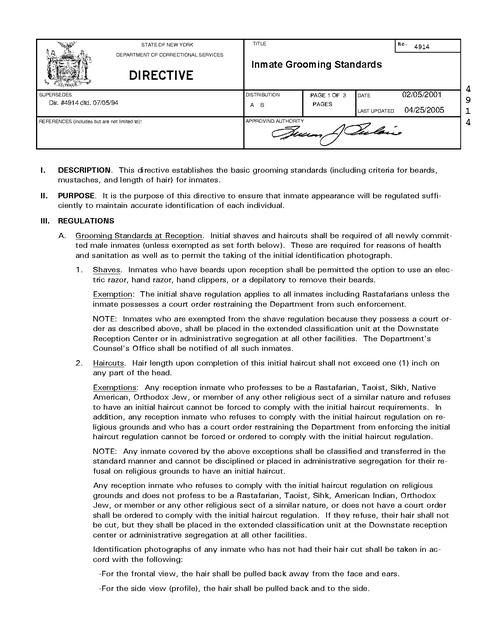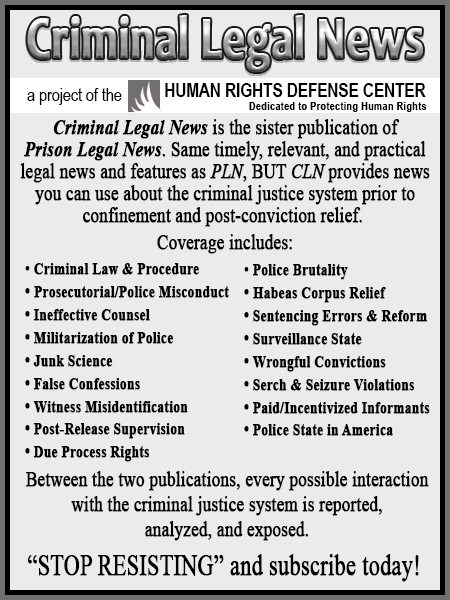Nydocs Grooming Policy 2005
Download original document:

Document text

Document text
This text is machine-read, and may contain errors. Check the original document to verify accuracy.
STATE OF NEW YORK No. TITLE 4914 DEPARTMENT OF CORRECTIONAL SERVICES DIRECTIVE Inmate Grooming Standards DISTRIBUTION SUPERSEDES Dir. #4914 dtd. 07/05/94 A B PAGE 1 OF 3 DATE PAGES LAST UPDATED REFERENCES (includes but are not limited to): 02/05/2001 04/25/2005 APPROVING AUTHORITY I. DESCRIPTION. This directive establishes the basic grooming standards (including criteria for beards, mustaches, and length of hair) for inmates. II. PURPOSE. It is the purpose of this directive to ensure that inmate appearance will be regulated sufficiently to maintain accurate identification of each individual. III. REGULATIONS A. Grooming Standards at Reception. Initial shaves and haircuts shall be required of all newly committed male inmates (unless exempted as set forth below). These are required for reasons of health and sanitation as well as to permit the taking of the initial identification photograph. 1. Shaves. Inmates who have beards upon reception shall be permitted the option to use an electric razor, hand razor, hand clippers, or a depilatory to remove their beards. Exemption: The initial shave regulation applies to all inmates including Rastafarians unless the inmate possesses a court order restraining the Department from such enforcement. NOTE: Inmates who are exempted from the shave regulation because they possess a court order as described above, shall be placed in the extended classification unit at the Downstate Reception Center or in administrative segregation at all other facilities. The Department's Counsel's Office shall be notified of all such inmates. 2. Haircuts. Hair length upon completion of this initial haircut shall not exceed one (1) inch on any part of the head. Exemptions: Any reception inmate who professes to be a Rastafarian, Taoist, Sikh, Native American, Orthodox Jew, or member of any other religious sect of a similar nature and refuses to have an initial haircut cannot be forced to comply with the initial haircut requirements. In addition, any reception inmate who refuses to comply with the initial haircut regulation on religious grounds and who has a court order restraining the Department from enforcing the initial haircut regulation cannot be forced or ordered to comply with the initial haircut regulation. NOTE: Any inmate covered by the above exceptions shall be classified and transferred in the standard manner and cannot be disciplined or placed in administrative segregation for their refusal on religious grounds to have an initial haircut. Any reception inmate who refuses to comply with the initial haircut regulation on religious grounds and does not profess to be a Rastafarian, Taoist, Sihk, American Indian, Orthodox Jew, or member or any other religious sect of a similar nature, or does not have a court order shall be ordered to comply with the initial haircut regulation. If they refuse, their hair shall not be cut, but they shall be placed in the extended classification unit at the Downstate reception center or administrative segregation at all other facilities. Identification photographs of any inmate who has not had their hair cut shall be taken in accord with the following: -For the frontal view, the hair shall be pulled back away from the face and ears. -For the side view (profile), the hair shall be pulled back and to the side. 4 9 1 4 ________________________________________________________________________________________________________________________ NO. 4914 Inmate Grooming Standards DATE B. 02/05/2001 PAGE 2 OF General Grooming Standards. After the initial haircut and shave, general grooming standards as set forth below are applicable to all inmates except those inmates participating in the Department's Shock Incarceration Program. 1. Beards and Mustaches. An inmate may grow a beard and/or mustache, but beard/mustache hair may not exceed one (1) inch in length unless a. the inmate has a court order restraining the Department from enforcement; or b. the inmate has requested and received an exemption based upon his or her documented membership in a religion which has an established tenet against the trimming of beards including but not limited to inmates who are Rastafarian, Orthodox Jew or Muslim. All inmate requests for such exemption shall be referred to and reviewed by Counsel's Office after consultation with the facility chaplain. After such review, Counsel's Office will make a recommendation to the Deputy Commissioner for Correctional Facilities. If the request is approved by the Deputy Commissioner for Correctional Facilities, a permit will be issued to the inmate. Further, pending Counsel's Office's determination of requests for exemption from the one (1) inch rule, inmates shall not be required to cut or trim their beards, or disciplined for refusing the order to shave or subject to repeat orders to shave. An inmate who refuses to comply with this rule will be given 14 days from the date of the written order to shave in which to request an exemption. If the inmate fails to submit a request for an exemption within 14 days, he may be disciplined for refusal to obey such order. Copies of the written order, an inmate's request for exemption and the exemption will be filed in the inmate's legal file. 2. Hair. a. Only basic haircuts will be allowed. Only one straight part will be allowed with no other lines, designs or symbols cut into the hair. In accordance with established barbering guidelines of the Department's Occupational Training Program, basic haircuts are defined as: short, medium, and long short, medium, and long pompadour crew flat top butch quo vadis (bald) Afro-natural, and elevation Hair may be permitted to grow over the ears to any length desired by the inmate. The hair must be neatly groomed and kept clean at all times. The only braids allowed are the corn row style. Corn row braids may only be woven close to the scalp in straight rows from the forehead to the back of the neck. No designs or symbols may be woven into the hair and the corn row braids may not extend below the hairline. b. Long hair is defined as below shoulder length. c. Inmates wearing long hair assigned to work near machinery or food shall be required to wear a hair net. Any other inmate assigned to work near food shall be required to wear either a hat or a hair net. d. All inmates wearing long hair will be required to have the hair tied back in a ponytail at all times with a barrette, rubber band or other fastening device approved by the Superintendent. Exception: Native Americans involved in scheduled and approved Native American cultural ceremonies do not have to comply with this restriction. e. An inmate may be subjected to a hair search when there is reason to believe that contraband may be discovered by such a search. An inmate may be subjected to such search at any time that a pat frisk, strip search, or strip frisk is being conducted. Consistent with 3 ________________________________________________________________________________________________________________________ NO. 4914 Inmate Grooming Standards DATE 02/05/2001 PAGE 3 OF Directive #4910, during a pat frisk, an inmate will be required to run fingers through hair. During a strip search, an inmate may be subjected to an inspection of his or her hair. During a strip frisk, an inmate will run his or her hands through the hair. C. Photographs. If, in the opinion of a Correction Officer or supervisor, an inmate drastically changes his appearance by changing the length, style and/or color of his hair, or growing or shaving a beard and/or mustache, he will be rephotographed for identification purposes. All such rephotographs will be at the expense of the inmate. 3





